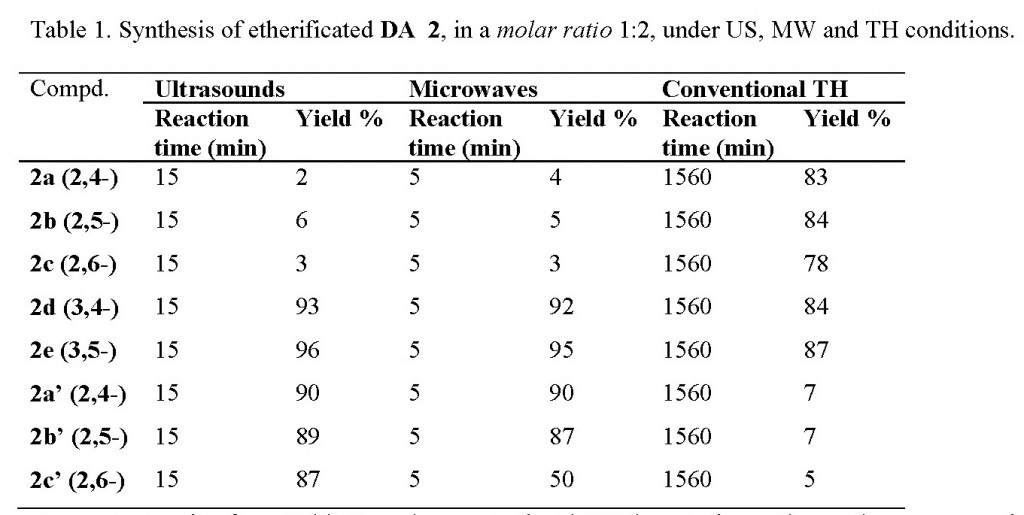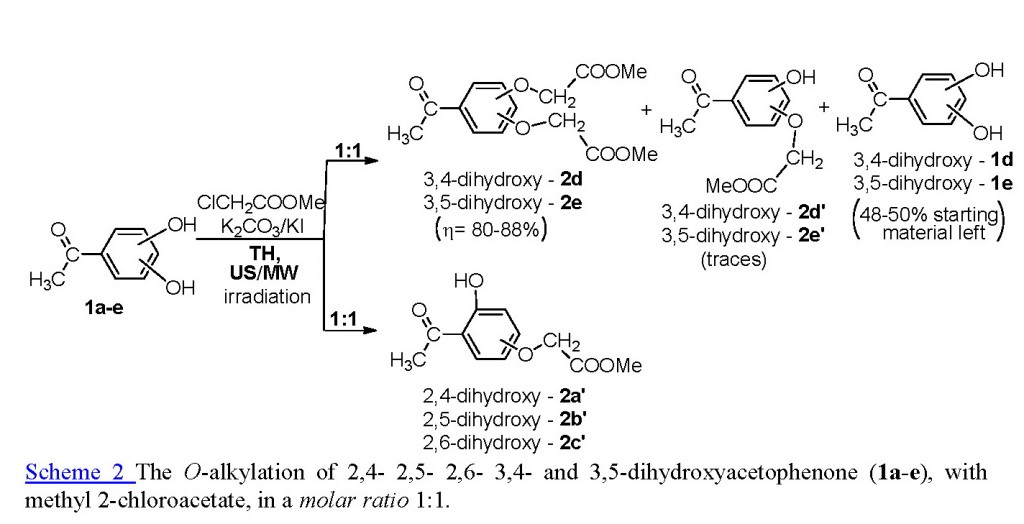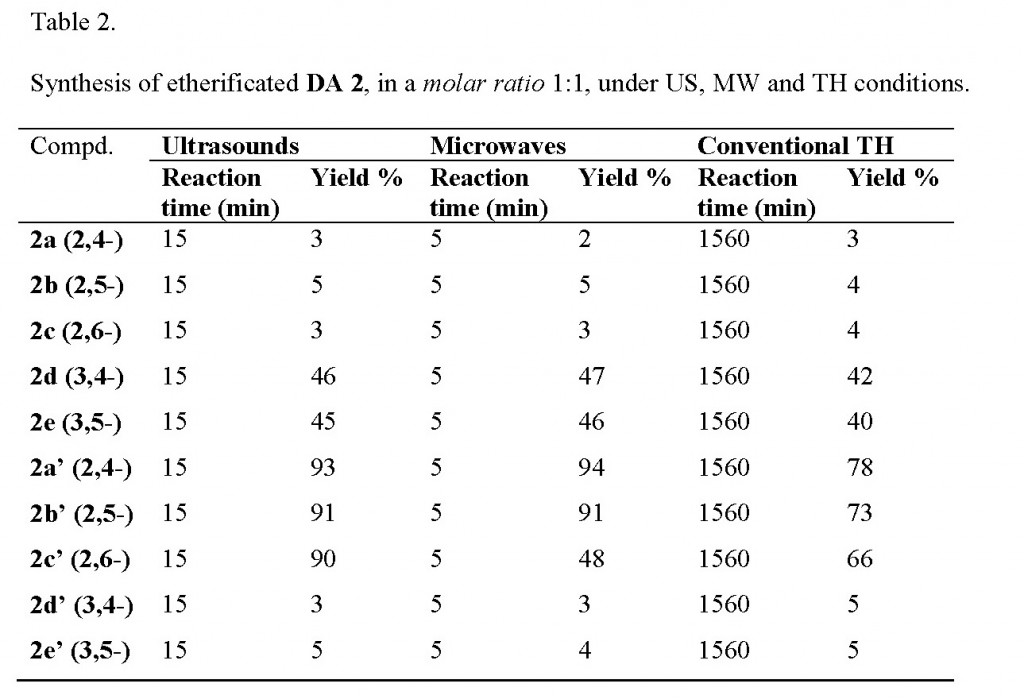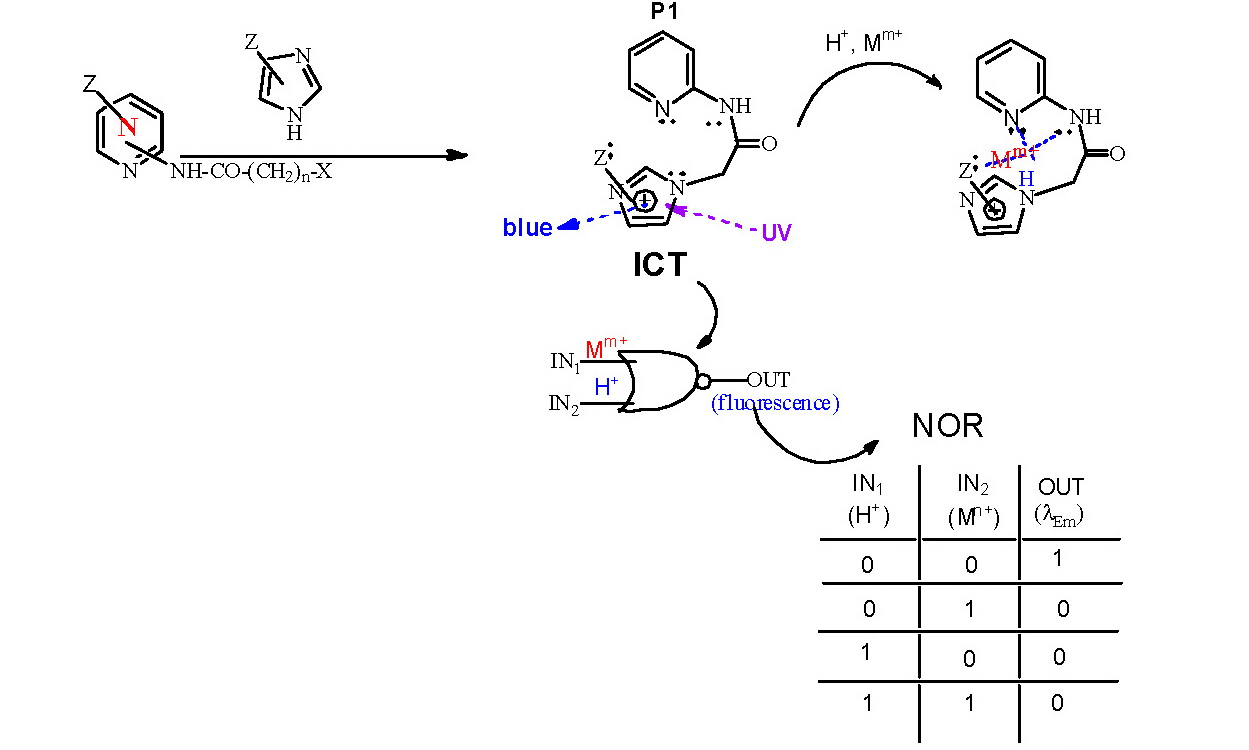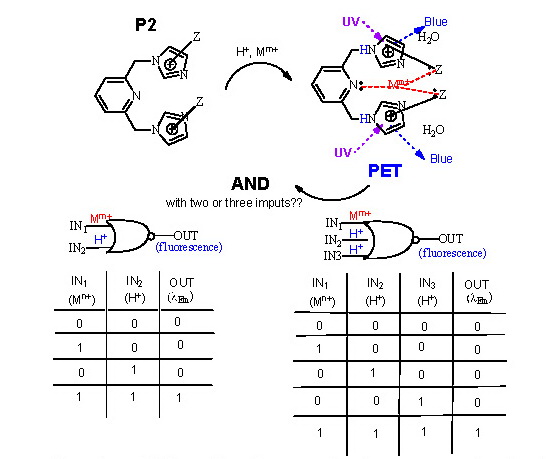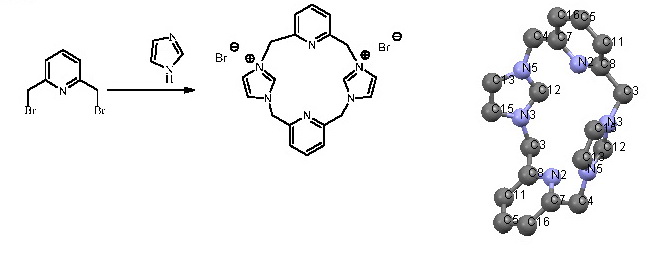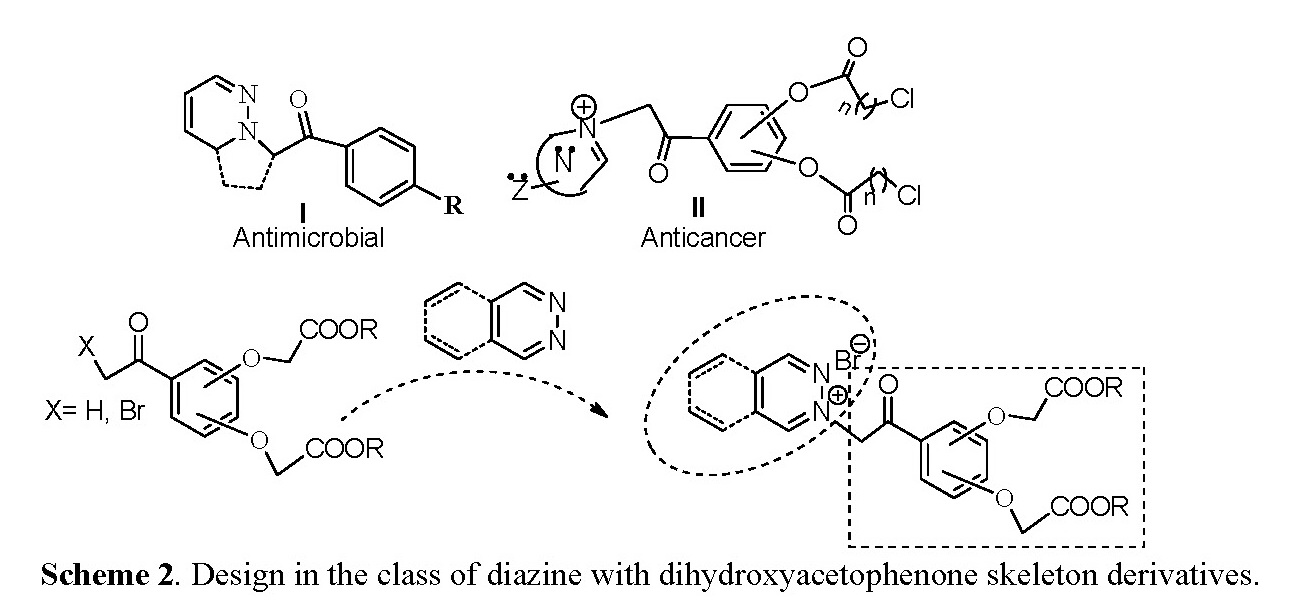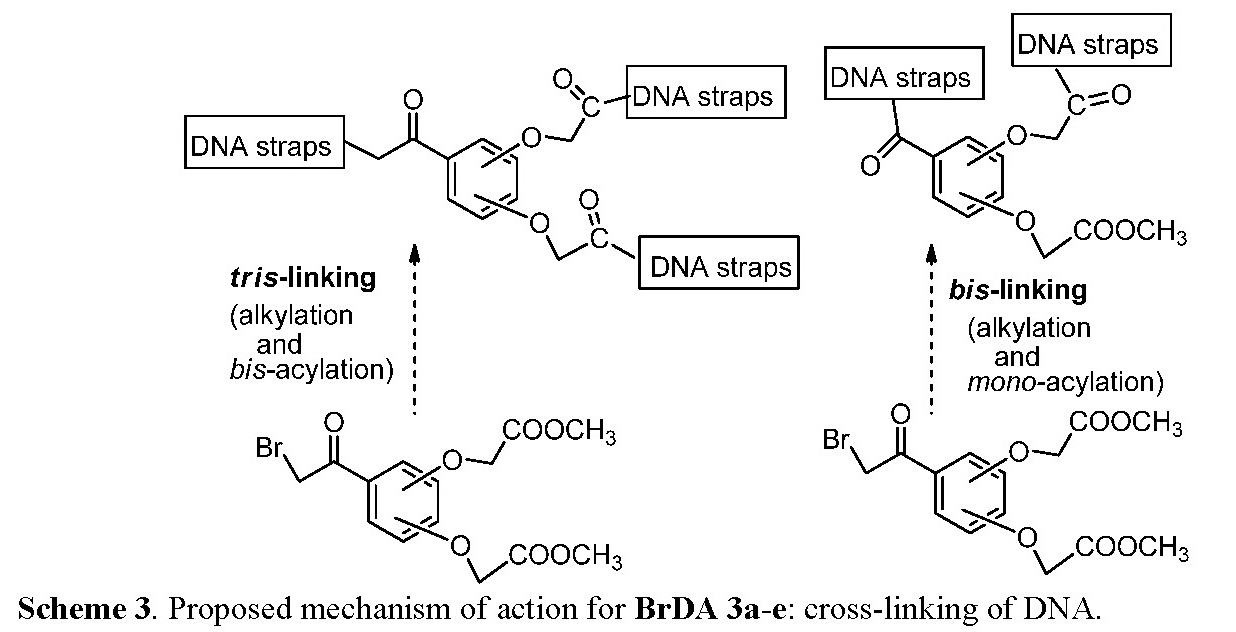1st Stage Report
2012. Stage I. Synthesis and structural analysis of intermediars and podant derivatives
In this stage there will be bring it contributions to objectives O1, O2, O5-O7.
A.I.1. Synthesis of 6 member ring nitrogen p–deficient and 5 member ring nitrogen p–reach heterocycles by conventional methods
A.I.2. Synthesis of diols with acetophenone skeleton by conventional methods
A.I.3. Synthesis of 5 member ring and 6 member ring nitrogen heterocycles and diols intermediary (obtained in AI.1 and AI.2 by conventional methods), using MW and/or US technology.
In summary, these syntheses have been performed according to the following scheme:
Some details that already appear in papers accepted for publications:
The strategies adopted for construction of our newly dihydroxyacetophenone derivatives DA derivatives involves mainly three types of reactions: O-alkylation, a-bromination and N-alkylation. We studied these reactions under conventional TH, US and MW irradiation.
The first investigated reaction was the bis-O-alkylation of 2,4- 2,5- 2,6- 3,4- and 3,5-dihydroxyacetophenone (1a-e), with methyl 2-chloroacetate, in a molar ratio 1:2 (Scheme 1).
Scheme 1 .The O-alkylation of 2,4- 2,5- 2,6- 3,4- and 3,5-dihydroxyacetophenone (1a-e), with methyl 2-chloroacetate, in a molar ratio 1:2.
Under conventional thermal heating (TH) we obtained the expected bis-etherificated DA (2a-e), in moderate yields (Table 1). Unexpectedly, in the case of dihydroxyacetophenone bearing a hydroxyl group in the 2 position (2,4-; 2,5-; 2,6-), we obtained and some small amounts of mono-etherificated DA, 2a’-c’.
As we may notice from Table 1, under conventional TH the reaction pathways have some major disadvantages, including moderate yields and selectivity, long reaction time (1560 min), high energy consumption, considerable amounts of solvents, etc. For these reasons we decided to use ultrasound and microwave irradiation, as nonconventional methods, for the synthesis, Scheme 1. The reactions under US irradiation were carried out using a Sonoplus GM 3200 reactor (Bandelin, Germany) with a frequency of 20 KHz and a nominal power of 200 W. The MW assisted reactions were carried out using a 800 W STAR SYSTEM-2 monomode reactor (CEM Corporation). In all cases, under US and MW irradiation, the reaction time decreases substantially (to 5 respectively 15 min), the consumed energy decreased considerably and, the amount of used solvent is at least 4 times less (see Experimental Section) comparative with conventional TH, the O-alkylation reaction could be considered environmentally friendly. We may also notice that, in most cases, under US and MW irradiation the yields are higher with 10-15%.
As indicated in Table 1, under US and MW irradiation, the O-alkylation reactions occur different according with the relative position of the two hydroxyl groups on the acetophenone ring. When the hydroxyl groups are in 3,4- and 3,5- position, a selective bis-O-alkylation reaction occurs, being obtained the bis-etherificated DA 2d,e, in very good yields. When the hydroxyl groups are in 2,4-, 2,5-, and 2,6- position, unexpectedly, a selective mono-O-alkylation reaction occur, the hydroxyl group from 2-possition of phenyl ring remaining non-alkylated. Thus, the mono-alkylated compounds (DA 2a’-c’) were obtained as major products (good to moderate yields) while the bis-akylated compounds (DA 2a-c) were obtained only in traces.
Having in view the above considerations, especially those one related to selectivity, we decide of to perform the same reaction using a different molar ratio, 1:1 (Scheme 2).
Table 2 lists the optimized conditions we employed, under conventional TH, US and MW irradiation in a molar ratio 1:1. As we may notice from Scheme 2 and Table 2, no matter the conditions we employed (US, MW and TH conditions), the reactions pathway occurs different, according with the structure of dihydroxyacetophenone. In the case of DA bearing the hydroxyl group in the 2-possition of phenyl ring, the reactions occur highly selective, only mono-O-akylation took place and, the mono-alkylated compounds (DA 2a’-c’) are obtained in very good yields. The results are completely surprising in the case of 3,4 – and 3,5-dihydroxyacetofenone: despite of the 1:1 molar ratio, the bis-O-akylation occur mainly, being obtained a mixture of bis-etherificated DA 2d,e, traces of mono-etherificated DA 2d’,e’ and unreacted starting material, dihydroxyacetophenone 1a,e (around 50%).
A feasible explications for the mono-O-akylation of dihydroxyacetofenone bearing a hydroxyl group in the 2-possition of phenyl ring, could be the intramolecular hydrogen bonds that appear in such type of compounds, as we proved by X-ray measurements in a previously paper in the case of 2,4-dihydroxyacetofenone. In these compounds a powerful intramolecular hydrogen bond between the hydroxyl group in the 2-possition and the neighboring carbonyl group (O-H—O=C) take place. Consequently, the O-akylation reactions will take place to the remaining hydroxyl group from 4-, 5- or 6- position of phenyl ring.
In the next step we investigated the bromination reaction of bis-etherificated DA, 2a-e, Scheme 3. As bromination method we have chosen a previously procedure reported by us, the bromination in heterogeneous catalysis using copper (II) bromide in chloroform / ethyl acetate. This reaction system is highly selective, leading to a-bromo-derivatives in very good yields. Using this procedure, we performed the bromination of DA derivatives 2a-e with copper (II) bromide, under conventional TH, US and MW irradiation. In the table 3 are listed the optimized conditions we employed.
As indicated in Table 3, the bromination of bis-etherificated DA 2a-e occur highly selective in a-position, no nuclear bromination taking place. The yields are moderate under conventional TH and good under US irradiation, a significant increasing of yields being observed (with an average of 10-15%). Unexpectedly, under MW irradiation, no matter the condition we employed, we obtained only traces of desired brominated DA 3a-e, and starting materials left. Incomplete reaction is indicated by finding unreacted copper (II) bromide in the final reaction mixture and by total ion chromatograms (TIC) recorded by GC-MS. As an example, we present the total ion chromatogram for the bromination of 3,5-dihydroxyacetophenone derivative, Figure 1. This inefficiency of MW irradiation could be attributed to an inefficient stirring of catalyst, copper (II) bromide always remaining at the bottom of the reaction vessel.
Concerning the efficiency of US irradiation in the bromination reaction of bis-etherificated DA, we presume that this efficiency is due to the cavitations phenomena, the energy being more efficiently transmitted to the substrates compared to the reactions performed under conventional conditions. Also, the collapse of bubbles induces mechanical stress that can be transmitted to a target single bond, this phenomena being a specificity of ultrasound action.
Taking into consideration the advantages offered by US catalytic bromination in terms of better yields, substantially decreasing of consumed solvent (at least two-fold less comparative with conventional TH), substantially reaction time decreasing and consequently energy decreases, this bromination method could be considered an environmentally friendly one.
In the final stage, we studied the N-alkylation reaction of the six member 1,2-diazine heterocycles, Scheme 4. In this respect pyridazine and phthalazine were N-alkylated with a-brominated DA 3a-e, the corresponding diazine with dihydroxyacetophenone skeleton derivatives (4a-e and 5a-e), being obtained, Scheme 1. In the table 4 are listed the optimized conditions used for N-alkylation, under US, MW and conventional TH.
A comparative analysis for the obtained data leads to the conclusion that the use of US and MW irradiation induced for N-alkylation reaction a remarkable acceleration, the reaction times decreasing from 48 hours to 15 respectively 5 min. We may also notice that under US and MW irradiation the yields are higher (by 10 to 15 %) and the amount of used solvents is 4 times less. Consequently the N-alkylation reaction under US and MW irradiation could be considered environmentally friendly.
The structure of compounds was proved by elemental and spectral analysis [IR, MS, 1H NMR, 13C NMR, 2D-COSY, 2D-HETCOR (HMQC), long range 2D-HETCOR (HMBC)], and are in accordance with the proposed structure.
Conclusion
In conclusion, a thoroughly study concerning O-alkylation and a-bromination of dihydroxyacetophenone and N-alkylation of 1,2-diazine, under ultrasound and microwave irradiation as well as under conventional heating is presented. Taking into consideration the advantages offered by US and MW irradiation in terms of better yields, substantially decreasing of consumed solvent (several-fold less comparative with conventional TH), substantially reaction time decreasing (from hours or days to minutes) and consequently energy decreases, the O-alkylation, a-bromination and N-alkylation methods could be considered environmentally friendly. A selective and efficient way to either bis-O-alkylation or either mono-O-alkylation of DA has been found, the relative position of the two hydroxyl groups on the phenyl moiety being compulsory. When the hydroxyl groups are in 3,4- and 3,5- position, no matter the conditions are employed (molar ratio, US and MW irradiation, conventional TH), the bis-O-alkylation reaction occur, with a maximum efficiency under US and MW irradiation. In the case of DA bearing the hydroxyl group in the 2-possition of phenyl ring, selective ways to either bis-O-alkylation either mono-O-alkylation has been found. When bis-O-alkylation is desired, the reactions have to be conducted under conventional TH, in a molar ratio 1:2. When mono-O-alkylation is desired, the reactions have to be conducted under US or MW irradiation, in a molar ratio 1:1. A feasible explications for the mono-O-akylation of dihydroxyacetofenone bearing a hydroxyl group in the 2-possition of phenyl ring was furnished, being assumed to the intramolecular hydrogen bond between the hydroxyl group in the 2-possition and the neighbouring carbonyl group. A selective and efficient way for -bromination in heterogeneous catalysis of DA derivatives under US irradiation is presented. The efficiency of US irradiation in the bromination reaction of bis-etherificated DA is assumed to the cavitations phenomena. The N-alkylation reaction of DA under US and MW irradiation it proved to be the most convenient setup procedure for these types of reactions. Overall the use of US it proved to be more efficient than MW or TH.
A.I.4. Synthesis of new nitrogen podant type P1 having in the same molecule at a p–reach and a p–deficient heterocycle connected via different spacers.
In order to reach this goal, we chose a simple and efficient way of synthesis:
In the second step, P1 was tested as chemosensor (complexation with metals, Mm+) and as logic gate of type NOR (complex either H+ or Mm+), P1 being a fluorophore-spacer-receptor system.
A.I.5. Synthesis of new nitrogen podant type P2 having in the same molecule at a p–reach and a p–deficient heterocycle connected via different spacers.
The synthesis of P2 podant were performed according with the following direct and efficient strategy:
In the second step, P2 was tested as chemosensor (complexation with metals, Mm+) and as logic gate with two (or three) inputs [H+(2H+)and Mm+] and one output (fluorescence), a fluorophore-spacer-receptor-spacer-fluorophore system.
According with the molar ratio we employed new macrocycles structures could be obtained. For instance in the case of bis-dibromomethylene-pyridine and imidazole, coronand P2’ was obtained:
Such type of structures, P2’, could also have potential applications.
A.I.6. Evaluation of the biological active properties
Some of the newly obtained compounds was tested as follow as potential antimicrobials and antitumoral drugs. Some details that already appear in papers accepted for publications:
Design and biological activity
Recently, we reported successful results on the identification of new antimicrobial (type I) and anticancer (type II) compounds which contain a diazine–acetophenone skeleton as pharmacophoric moiety. As a consequence, in an attempt to increase the potential of pharmacophoric models, we decided to combine their respective biological potentials. In this respect a bis-etherificated DA unitwas grafted onto a diazine heterocycles, Scheme 2.
The bis-etherificated DA would probably act as bis-acylation units, analogous to bis-alkylating units from nitrogen mustards anticancer derivatives. As a whole, the entire molecule of DDA could exert both antimicrobial and anticancer activity.
The synthesized compounds were preliminary tested for their in vitro antimicrobial activity against six different strains of Gram-positive (Staphylococcus aureus ATCC 25923, Sarcina lutea ATCC 9341, Bacillus cereus ATCC 14579, Bacillus subtilis) and Gram-negative (Escherichia coli ATCC 25922, Pseudomonas aeruginosa ATCC 27853) bacteria, respectively to three yeast strains (Candida albicans ATCC 10231, Candida glabrata ATCC MYA 2950, Candida sake). The preliminary screening was carried out by agar diffusion assay using nutrient agar medium (Mueller Hinton agar for antibacterial tests and Sabouraud agar for antifungal tests). Ampicillin, chloramphenicoland nystatin were used as reference drugs. Tables 3 and 4 summarize the antimicrobial activity of the compounds and reference drugs. The results are expressed as diameters of inhibition zones (mm).
As indicated in Table 3, almost all tested compounds had a significant activity against Pseudomonas aeruginosa ATCC 27853. From experimental point of view, this result has a significant importance, drug resistance of Gram-negative bacteria being well known (because of their lipopolysaccharide–rich outer membrane, which reduces the penetration of antibiotics [26]). We may also notice that, all tested compounds have an excellent antibacterial activity against Gram-positive strain Bacillus cereus, the activity of brominated compound 3e (3,5-disubstituted) being spectacular (3e has a larger inhibition zone even than Chloramphenicol). The brominated compounds 3c and 3d have also a very good antibacterial activity against B. cereus, the inhibition zone being comparable to that one of Chloramphenicol. Compounds 3e and 3a (brominated DA) showed also a good antibacterial effect against S. aureus.
If we compare the effects of non-brominated DA 2a-e with those of the brominated analogues 3a-e, we may notice a spectacular increasing of antibacterial activity for brominated compounds.
In the case of diazine with dihydroxyacetophenone skeleton derivatives DDA (4a-e, 5a-e) an unexpected behaviour occurred. Literature data shows that diazine salts with acetophenone skeleton possess a very good antimicrobial activity. As far for our DDA derivatives this thing is not happen, the antibacterial activity being lower comparable with the brominated BrDA analogues.
The antifungal effects of synthesized compounds expressed as diameters of inhibition zones (mm) are shown in Table 4.
As shown in Table 4, all the compounds have a good to moderate antifungal activity, non-selective, against all pathogenic yeasts used. Compounds 2b and 2c show a good activity against Candida albicans ATCC 10231, their zones of inhibition being comparable to that of Nystatin. The inhibition zone developed by 18 derivatives (except five salts: compounds 4b, 4c, 4e, 5a and 5b) against Candida sake was larger than 20 mm.
The in vitro anticancer activity of the synthesized compounds was evaluated and screened against human cervix epithelial carcinoma cell line (HeLa). At least four concentrations were tested for each compound: 200, 300, 400 and 500 µg/mL (the brominating compounds showed a very good antitumoral activity that is why they were tested also at 25, 50 and 100 µg/mL). The results were expressed as IC50, which is the concentration of the drugs inducing a 50% inhibition of cell growth. Each experiment was performed five times. 5-Fluoro-uracil, Etoposide and Methotrexate were used as the reference drugs. Table 5 summarizes the antitumoral activity of the compounds expressed as IC50.
The in vitro evaluation revealed that some of the tested compounds show high or moderate antitumoral activity. The brominating compounds 3a-e proved to be the most active against the HeLa cells. We may notice that the antitumoral activity decreases in order 3c (IC50 38.6 μg/mL, 2,6-disubstituted BrDA) > 3a (IC50 43.1 μg/mL, 2,4-disubstituted BrDA) > 3e (IC50 75.9 μg/mL, 3,5-disubstituted BrDA) > 3b (IC50 112.9 μg/mL, 2,5-disubstituted BrDA) > 3d (IC50 218 μg/mL, 3,4-disubstituted BrDA). These results allow us to presume that most probably the brominated compounds exert their cytotoxic effects by interstrand cross-linking of DNA. Thus, it could be suspected two major pathways: a tris-linking of DNA (a mono-alkylation and a bis-acylation) and a bis-linking of DNA (a mono-alkylation and a mono-acylation), Scheme 3.
We may also notice from Table 5 that non-bromurated DA 2a-e have only a moderate cytotoxic activity (IC50 betwen 387 to 504 μg/mL), and, as mechanism for these compounds only a bis-acylation of DNA could be involved. Taking into consideration these assertions, we may postulate which will be the ester group involved in acylation in the case of a bis-linking of DNA: the group located in 2 or 3 positions onto phenyl ring.
Conclusion
The in vitro antimicrobial and anticancer activities of the DA, BrDA and DDA compounds have been evaluated. The tested compounds have an excellent antibacterial activity against Gram-positive strain Bacillus cereus and, more significant, against drug resistant Gram-negative strain Pseudomonas aeruginosa. SAR correlation reveals that the brominated derivatives BrDA have the most powerful antibacterial activity, the influence of bromine atom being certain. All the tested compounds have a moderate antifungal activity. The in vitro antitumoral evaluation revealed that some of the tested compounds show high or moderate anticancer activity. The brominated derivatives BrDA proved to be the most active against HeLa cells. Regarding the mechanism of action we presume that, most probably, our brominated compounds exert their cytotoxic effects by interstrand cross-linking of DNA via two pathways: a tris-linking of DNA (a mono-alkylation and a bis-acylation) and a bis-linking of DNA (a mono-alkylation and a mono-acylation).
A.I.7. Elemental and structural analysis of the obtained structures. Final stage report
The structure of the newly compounds was proven through elemental and structural analysis: IR, NMR, UV-Vis and fluorescence, MS, X-ray.
A final stage report was accomplished and it was presented on the web page of the project.
Achievements
- Inventory Materials Acquired
Monomod Microwave Reactor Monowave 300 (Anton Parr) (15000€), Kugelrohr (10000€), Hydrogenation parr apparatus (10000€), rotaevaporatory (8000€), Dewars devices (5000€), magnetical stirrers (1000€).
- Results Disseminations
– Two papers:
- Dorina Mantu, Eliza Ene, Vasilichia Antoci, Ana Maria Zbancioc. Diazolium Salts with Dihydroxyacetophenone Skeleton with Anticipated Anticancer and Antibacterial Activity, Acta Chimica Iasi, 21(1), 9-18, 2013
- Zbancioc, A.M.; Miron, A.; Moldoveanu, C.; Zbancioc, Ghe. Imidazolium Salts with Dihydroxyacetophenone Skeleton with Anticipated Anticancer Activity. Part II, Rev. Chim. Bucharest, 64(6), 584-586, 2013.
– Two papers submitted for publication:
- Zbancioc, A.M.; Miron, A.; Cristina Tuchilus, Pincu Rotinberg, Cosmin Teodor Mihai, Mangalagiu, I. I.; Zbancioc, Ghe. Dihydroxyacetophenone Derivatives: Syntheses, Antitumoral and Antimicrobial Activity, ChemMedChem, submited, 2013.
- Zbancioc, Ghe.; Zbancioc, A.M.; Mangalagiu, I.I. Ultrasound and microwave assisted synthesis of dihydroxyacetophenone derivatives with or without 1,2-diazine skeleton, Ultrason. Sonochem., submited, 2013
– Papers presented to Scientific Meetings: 10
1. Mangalagiu, I.I.: NEW POLIFUNCTIONAL NITROGEN DERIVATIVES AS SMART VERSATILE BUILDING BLOCKS FOR MULTIPLE TASKS, The XVII-th International Conference „Physical Methods in Coordination and Supramolecular Chemistry” (PPMCSC-XVII), Chisinau, 24 – 26 Octombrie 2012, O19, pag. 53 (oral presentation). ISBN 978-9975-62-327-8
2. Antoci, V.; Mantu, D.; Zbancioc, Ghe.; Moldoveanu, C.; Mangalagiu, I.I.: UV-VIS STUDIES OF NEW ISOINDOLO-1,2-DIAZINE COMPOUNDS WITH ACETOPHENONIC CHAIN , The XVII-th International Conference „Physical Methods in Coordination…” (PPMCSC-XVII), Chisinau, 24 – 26 Octombrie 2012, P6, pag. 63 (Poster). ISBN 978-9975-62-327-8
3. Mantu, D.; Antoci, V.; Nicolescu, A.; Deleanu, C.; Mangalagiu, I.I.: NMR STUDIES OF SOME 3(2H)-PYRIDAZINONE-ACETOHYDRAZIDES, The XVII-th International Conference „Physical Methods in Coordination and Supramolecular Chemistry” (PPMCSC-XVII), Chisinau, 24 – 26 Octombrie 2012, P54, pag. 140 (Poster). ISBN 978-9975-62-327-8
4. Bejan (Antoci), V.; Mantu, D.; Zbancioc, G.; Deleanu, C.; Mangalagiu, I.I.: SYNTHESIS UNDER ULTRASOUND IRRADIATION OF NEW PYRROLO-DIAZINIC COMPOUNDS WITH ACETOPHENONIC CHAIN Zilele Universitatii “Al. I. Cuza-Iasi“, 25 – 26 octombrie 2012, (P 17).
5. Mantu, D.; Antoci, V.; Moldoveanu, C.; Sova, S.; Nicolescu, A.; Mangalagiu, I.I. X-RAY STUDIES OF SOME UNEXPECTED FUSED AZAHETEROCYCLES Zilele Universitatii “Al. I. Cuza-Iasi“, 25 – 26 octombrie 2012, (P 19).
6. Zbancioc, G.; Moldoveanu, C.; Mantu, D.; Bejan (Antoci), V.; Mangalagiu, I.I. SYNTHESIS OF NEW CORONANDS AND SPIRO-DERIVATIVES USING ULTRASONIC IRRADIATION, Zilele Univ. “Al. I. Cuza-Iasi“, 25 – 26 octombrie 2012, (P 30).
7. Mangalagiu, I.I., Five and Six Member Ring Nitrogen Derivatives as Versatile Building Blocks in Chemistry, XXXII-nd ROMANIAN…., 3-5 October 2012, Calimanesti-Caciulata, Romania, C.P.-8, pag.8. (plenary lecture).
8. Bejan (Antoci), V.; Mantu, D.; Shova, S.; Mangalagiu, I.I., X-Ray Diffraction Studies of New Isoindolo-1,2-Diazine Compounds with Acetophenonic, XXXII-nd…, 3-5 October 2012, Calimanesti-Caciulata, Romania, P.S.I.-2, pag. 2. (poster).
9 Ene (Plesnicute), E.-L.; Bejan (Antoci), V.; Mantu, D.; Mangalagiu, I.I., One-pot Synthesis of New Pyrrolo-Diazine Compounds with Sulfonamide Chain, XXXII-nd…., 3-5 October 2012, Calimanesti-Caciulata, Romania, P.S.I.-4, pag. 4. (poster).
10. Zbancioc, Ghe.; Moldoveanu, C.; Antoci, V.; Mantu, D.; Mangalagiu, I., Synthesis of New Highly Functionalized Conorands or Spiro Derivatives Ultrasonic Irradiation, XXXII-nd ROMANIAN CHEMISTRY CONFERENCE, 3-5 October 2012, Calimanesti-Caciulata, Romania, P.S.I.-24, pag. 24. (poster).


